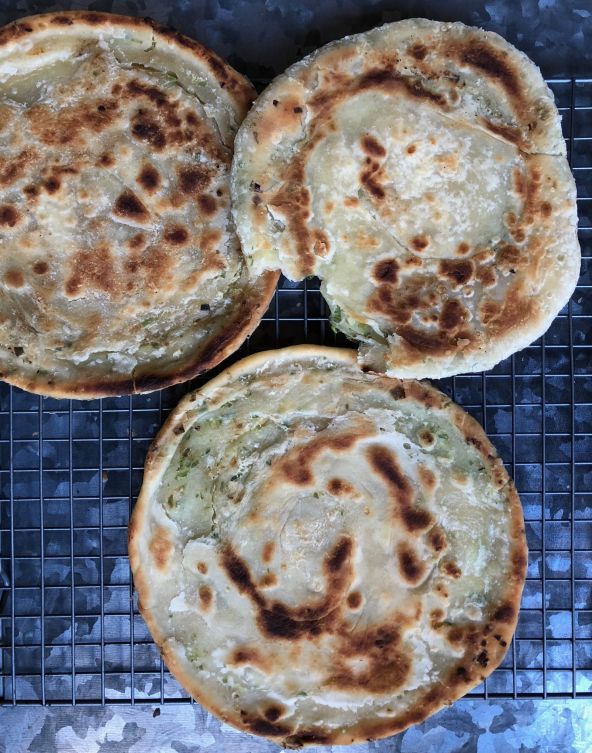
My husband adores scallion pancakes, even the sad, dry ones or weird tasting frozen ones I’ve bought at Asian markets. I’ve made them before from an old Sunset magazine recipe but have been looking for a better once ever since. Scallion pancakes are not made with batter, but rather with a soft-but-elastic dough. There’s shortening (lard, if you want to go whole hog), sesame oil and regular cooking oil involved. The rolled-out dough is panfried to a crisp, flakiness and served as a street snack or dim sum offering. They’re best freshly made. In Mandarin Chinese, the pancakes are called cōng yóu bǐng ( 蔥油餅) but on menus, you'll likely see them as scallion pancakes or green onion pancakes. The name looks boring but the pancakes themselves can be thrilling to eat when made well.
My friend Mary-Frances Heck, senior food editor at Food & Wine magazine, tipped me off to a scallion pancake recipe in Peter Meehan's Lucky Peach Presents 101 Easy Asian Recipes. She worked on the book while serving as the test kitchen director for Lucky Peach magazine. The scallion pancake recipe belonged to the family of a buddy of hers from culinary school, she said. “It’s the real deal,” Mary-Frances said.
I had to try it.
Aside from having a mild obsession with scallion pancakes, I’ve also been obsessed with Korean flour, which pastry expert Pichet Ong said is great for all kinds of Asian dumplings and pastries. I’ve got about 12 pounds of it in my pantry right now. It’s sold at Korean and some Chinese markets. The Bear brand, Pichet says, is what he and dumpling chefs use for certain Asian doughy morsels. The flour produces a tender texture that's desirable. What's in it? He's unclear but it works. Fine. I was game.
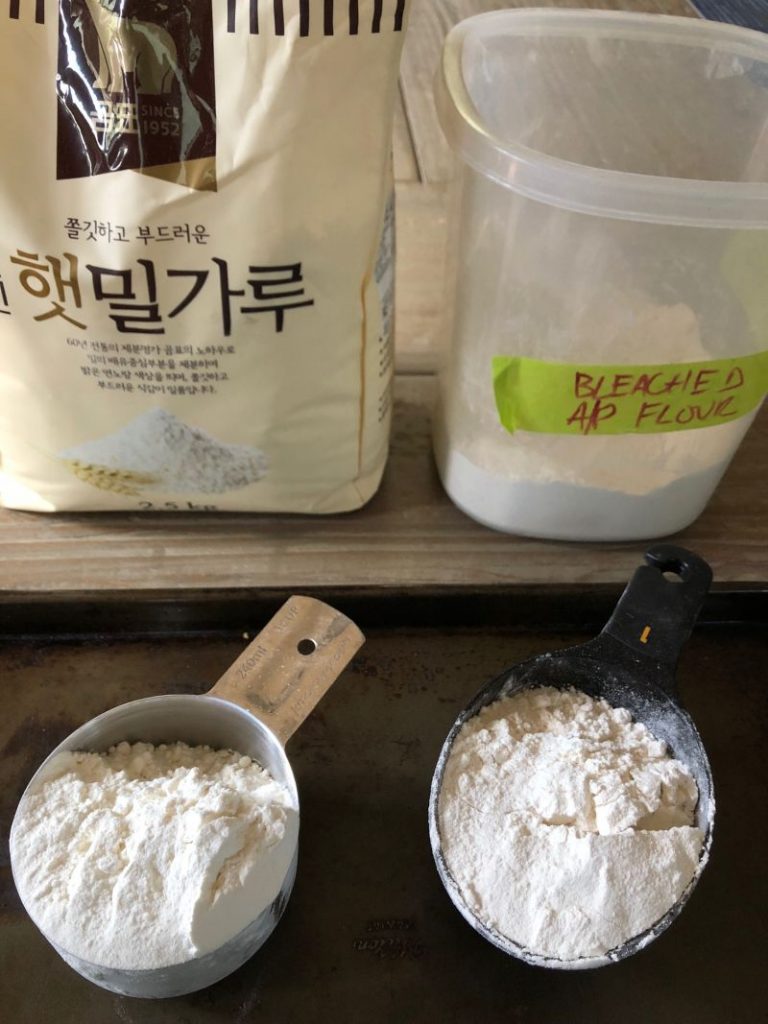
Wondering how the Bear would perform against Gold Medal bleached all-purpose flour, I made the scallion pancakes with both kinds of flour.
I've brought back flour from my travels to Singapore, Hong Kong, China and the American South (hello White Lily!). The flour from Asia can often be extremely fine, almost talc-like. It's hard to tell in the photo, but the Korean flour on the left has a slightly powdery texture. More of it stuck to my fingers than the Gold Medal all-purpose.
I made the two doughs up and the color difference was interesting, too. Also, the texture of the Korean flour-dough was a little softer, more Play-dohish. Perhaps it has a slightly lower level of gluten? The more yell0w-colored Bear flour is on the left in this photo:
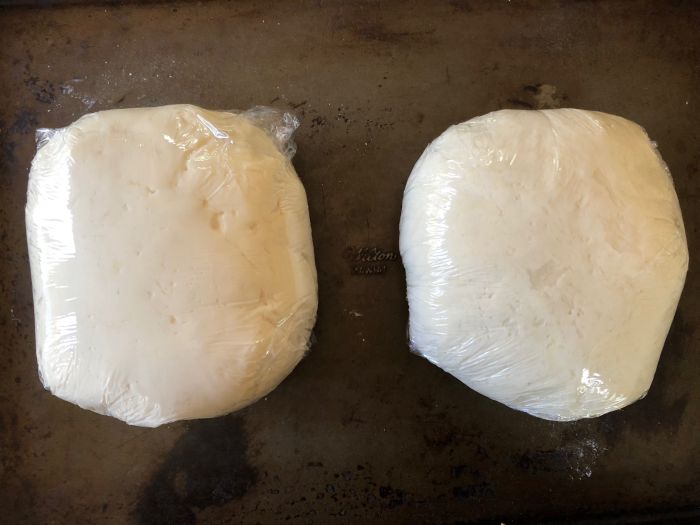
This scallion pancake dough is very interesting because it's made in two phases. The first phase yields a sticky, ragged dough that's been enriched with shortening. Then the remaining flour and water is added and worked into a very tender dough; there's little elasticity. After a quick rest, the dough is rolled out, filled, coiled, then rolled out again. It's super easy to work the dough and it's elastic enough to stretch but not unwieldy. It gives and yields with moderate pressure from the cook. I flew through rolling out the pancakes.
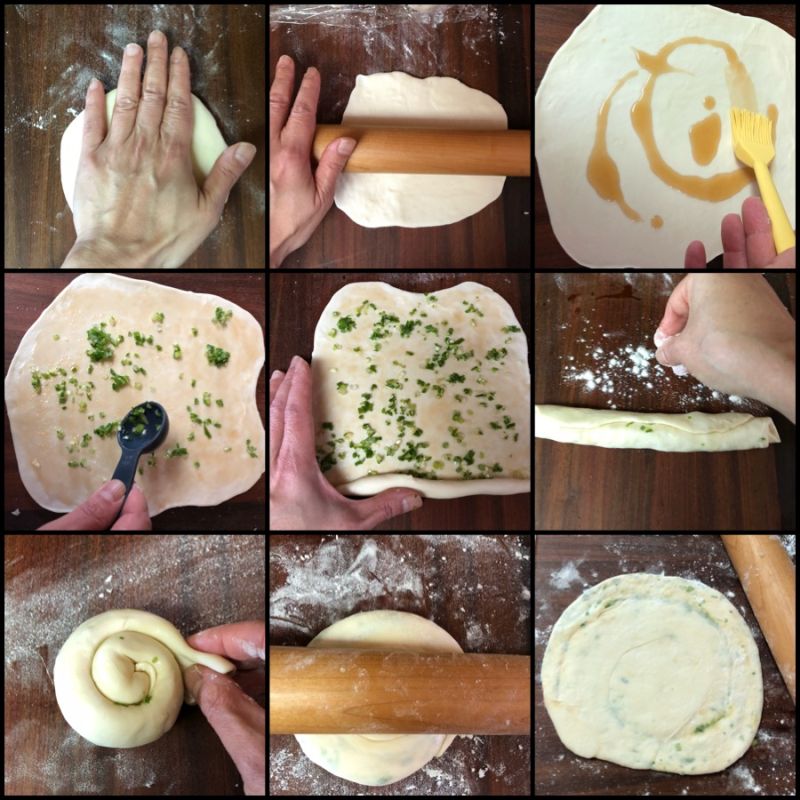
There was a marginal difference between the two flours when I went to shape the scallion pancakes. Then I cooked the pancakes, which was simple to do. There wasn't much of a difference between the two flours.
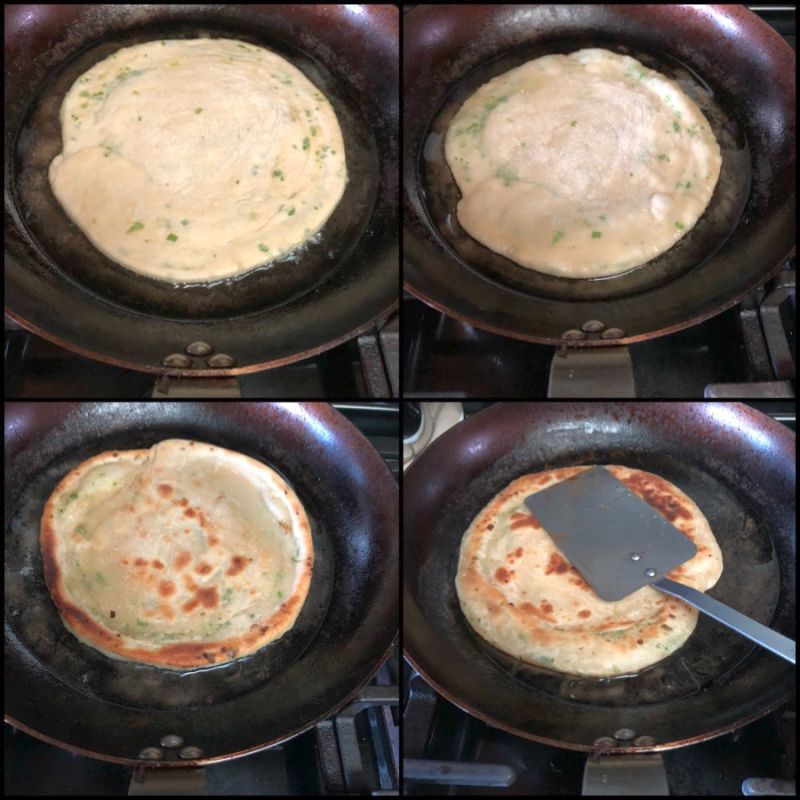
The finished pancakes below don't even look different. Of course, it boiled down to eating the pancakes side by side. My husband and I ate them warm, cold, and reheated in the toaster oven.
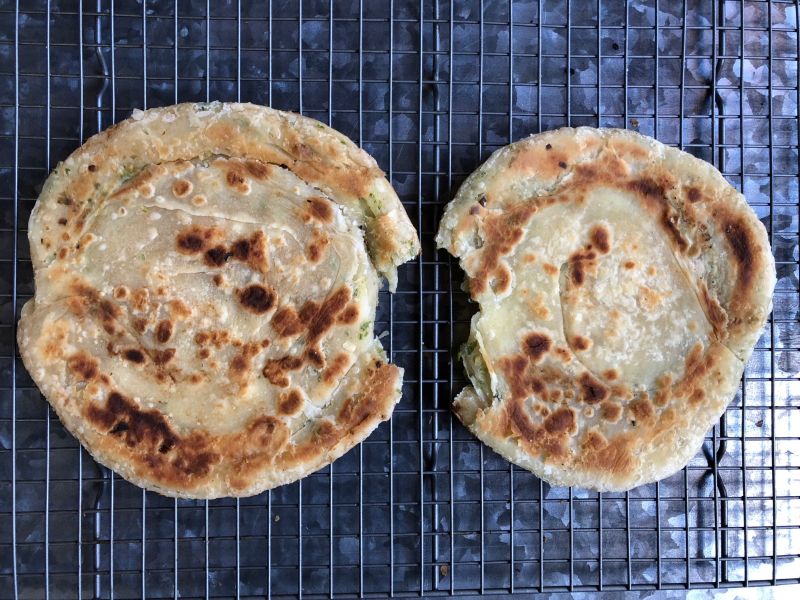
The Gold Medal flour scallion pancakes were remarkably great. It's a supermarket ingredient that you can use to successfully make a Chinese treat! Score a big win for that. However, the Korean flour yielded slightly more tender, better tasting pancakes. I emphasize very slightly. I don't read Korean Hangul so I have no idea what's in the flour. It's not weird, creepy tasteless, and overly bleached like some of the flour I've brought back from China. I liked it.
Should you go looking for Korean Bear flour to make scallion pancakes?
I'm not sure at this point because I've only used it for these pancakes. If you're a curious flour fanatic and shop at a Korean or Chinese market with a Korean clientele, look for it. I'll be using the flour on other recipes to see how it performs.
Regardless of what you use, consider the flour carefully. For example, I wouldn't use King Arthur all-purpose because it has a relatively high protein level. Dumplings made from KA flour tends to be more chewy than tender. That's why my flour of choice is Gold Medal; it's lower in protein and easily found.
Knowing what I know about flour differences, I'd also try Whole Foods organic unbleached flour, which is slightly more tender than Gold Medal; the WF flour may come close to the Korean flour. If you use White Lily, use it for the pancakes because you may get even more tender results since its protein (gluten) level is lower than most regular all-purpose flour. If the results are too tender, mix in some Gold Medal or even a little Italian Caputo "OO" flour typically used for pizza.
The cool thing is that this recipe is really good and not fussy. I use a Kitchen Aid stand mixer but you could mix it by hand, if you want. In any event, this recipe for scallion pancakes belongs in the category of easy Asian recipes, as the Lucky Peach cookbook suggests. Thanks Mary-Frances for the tip!!!
Related recipes
Chinese-Islamic Chinese Sesame Bread
Bacon and Scallion Pancakes (a fun 1973 recipe from Sunset magazine)
Scallion Pancakes
Yield 4 pancakes
Eat as is or serve with soy sauce, chile garlic sauce, sambal oelek, chile oil, Chinkiang vinegar (or 2 parts balsamic and 2 part cider).
Ingredients
- 1 ½ cup (7 ½ oz) plus 1 cup (5 oz) bleached all-purpose flour, plus more as needed
- 2 tablespoons (1 oz) shortening
- ¾ cup plus 2 ½ tablespoons warm (95-100F) water
- ½ teaspoon fine sea salt, or 1 teaspoon kosher salt, plus more as needed
- 2 to 3 tablespoons toasted sesame oil
- ¼ cup minced green onion, white and green parts
- Neutral oil, for panfrying
Instructions
- Use a stand mixer to make the dough. Put the 1 ½ cups flour and the shortening in a bowl. With the paddle attachment, run the machine on low speed for about 1 minute to break up the shortening into small pieces (you should barely be able to make them out). Pause the machine and add the ¾ cup water. Restart the machine and run for 2 to 3 minutes to make a moist, ragged dough. It will look stiff and sticky.
- Add the remaining 1 cup flour, 2 ½ tablespoons water and salt. Run the machine on low to combine all the ingredients. Pause to switch to the dough hook attachment. Knead the dough on medium speed for 2 to 3 minutes to form a soft, smooth dough. Transfer to a lightly floured surface, then gather and knead into a ball. The dough will feel somewhat slack. Push a finger into it and the indentation will hold. Wrap in plastic and let rest for 10 minutes or chill up to 2 days, returning to room temperature before proceeding.
- Lightly flour your work surface. Cut the dough into 4 pieces. Working with one at a time (keep the rest covered to avoid dry dough): Smack and pat the soft dough into a wide disk about ½ inch thick. Use a rolling pin to roll the dough into an 8-inch roundish piece. Roll from the center to edge and turn the dough 90 degrees with every other pass.
- Drizzle on a good 1 ½ teaspoons sesame oil then brush to within ½ inch of the edge. Sprinkle on a big pinch of salt. Distribute 1 tablespoon green onion on top. In a jelly-roll fashion, roll up the dough. Make it as tight as possible. Wind the log into a spiral, tucking the end underneath to keep the round shape. Expect a cinnamon roll shape at the end. Slide under plastic wrap then repeat to make 3 more. Once done, let rest 10 minutes or wrap individually and refrigerate for up to 1 day.
- Working with one dough spiral at a time, lightly coat it with flour. Use the rolling pin to roll the dough into a 7-inch round that’s a good ⅛-inch thick. Make 2 or 3 passes then turn the dough 90 degrees. When wet/oily dough and green onion break through the exterior (it often does), pat on flour to seal and keep rolling. Hold on a parchment paper-lined baking sheet or tray.
- Pour 2 to 3 tablespoons oil into a large (11 or 12-inch) skillet to thickly film the bottom. Heat over medium and when barely shimmering, add a pancake. Cook for 2 to 3 minutes on each side until crisp and filled with golden brown splotches. To avoid splattering oil, flip using 2 spatulas/turners. After turning once, you can gently press on the pancake to help it cook evenly. Cool for a few minutes on a rack before eating. Reheat in a 350F toaster oven for 5 to 8 minutes until hot and crisp. Eat hot or warm. Cut or tear.
Notes
Source: Peter Meehan's Lucky Peach Presents 101 Easy Asian Recipes (Clarkson Potter)
Courses breakfast, lunch, dinner
Cuisine Chinese













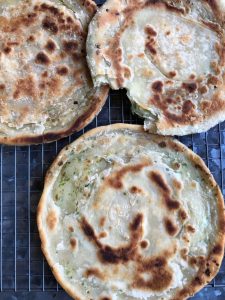
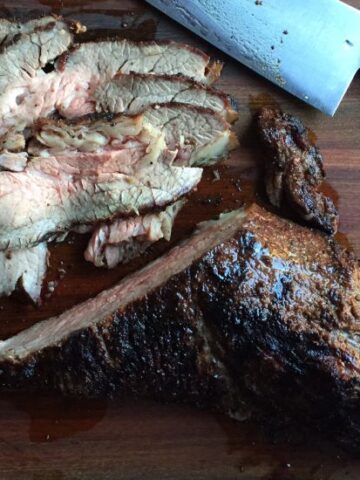


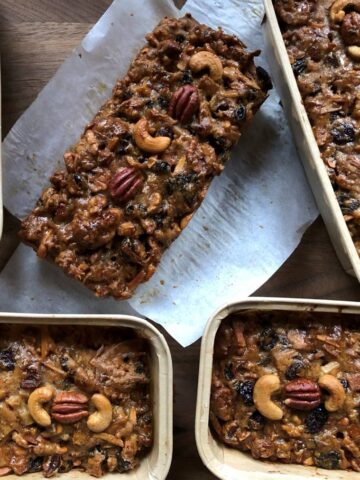
Don says
I am a serious home bread baker and I think the difference in color between the Korean flour and the GM AP flour is the Korean flour is probably unbleached. I have found through several flour tests that and unbleached flour has more flavor than a bleached flour. I am looking forward to testing this recipe soon. Thanks to taking your classes on Craftsy I have discovered the banh mi sandwich and tomorrow will be my second dinner serving Chinese BBQ pork banh mi with several different fixings. My youngest son was not sure about eating a banh mi so I only made one for him and after I finished mine he asked if there was anyway to get a second one. I love Asian food and I love sandwiches so a banh mi is a match made in heaven for me. Thank you for your teaching and recipes. Sometime, if you ever have any spare time i would like to talk about your banh mi roll recipe. Don
Andrea Nguyen says
Hi Don, the korean flour is somewhat pale yellow I'm not sure if it's unbleached. Bleached flour is favored in Asia but this one isn't brilliant or strangely white. It's an unusual animal. Thanks for taking time to write such a thoughtful note!
Bernice says
I'm excited to try these. we used to bring home hundreds of Cong Yong Bing from Taipei (Frozen) to last us for months because I have never found a recipe that worked that well. I will try this. If I don't have a standing mixer, is it okay to just mix with a wooden spoon or should I use a food processor? Thank you!
Bernice
Andrea Nguyen says
I'd mix by hand. Do you have a hand-held mixer? That may work with the right attachment. I've not used the processor but it's not great with developing gluten in dough.
Bernice says
Thank you. Ok. I’ll try by hand! Thank you!
Andrea Nguyen says
I was thinking about this after I responded to you, and maybe you could start it in the processor and finish kneading by hand. That business with the shortening can be messy.
Bernice says
I ended up doing it all by hand (I saw your comment when the dough was resting!) and the dough turned out beautifully anyway! I used a trusty wooden spoon and it came together really nicely. Thank you! I'm freezing a few and will see how they turn out frozen.
Andrea Nguyen says
I just thawed one and it was terrific. Thanks for reporting back, Bernice!
Karen says
I made these last night. They were wonderful. I have a question about the shortening volume measurement compared to weight. I used Crisco brand shortening, but 2 oz of shortening was a scant four tablespoons. My scale is accurate, so I ended up going with 2TBL of shortening, which was closer to one ounce. They were very delicious with the scant 1 oz of shortening, but i’m Somewhat confused about my discrepancy with volume to weight. Two ounces of shortening was nearly 4 TBL.
Andrea Nguyen says
Karen -- That was a typo on my part. Thanks for editing and pointing that out! It should be 2 tablespoons (1 ounce) of shortening. A stick of butter (8 tablespoons) weighs 4 ounces so 2 tablespoons will always be 1 ounce. Shortening and butter weigh the same. All that said, I'm so happy the recipe turned out well for you!!!
Suzette says
Mmm, now I am craving some! They are tasty on their own, but I seriously love them as a roll with thinly-sliced braised beef, cucumber, and hoisin sauce!!